I wanted to find out the pros and cons of different brands, materials, and gauges of baritone ukulele strings, so I’ve experimented with four different baritone ukuleles and numerous string sets over the past three years. I learned that a good set of strings can completely change the sound and playability of the instrument.
I also have reports from readers’ experiments in the results below. Feel free to let me know about your own experiments in the comments below or on the BaritoneUkes subreddit.
The four baritone ukes I have are a Lanikai S-B (spruce top, mahogany body), a Kimo custom (sinker redwood top, Claro walnut body), a Mike Pereira Cali (black walnut) and a Fanner electric (Telecaster-style). I also have a Kala tenor with standard re-entrant tuning (cedar top ziricote cutaway KA-ZTP-CTG-CE).

This article will be updated every time I try a new string set.
So far, my favorite set for acoustic bari uke is the Galli UX780 which I get from Strings By Mail. At twelve bucks, they aren’t cheap, but I love them.
Baritone Ukes Are Different from Traditional Ukes
The lowest note on a baritone uke is almost a full octave below the lowest note on a traditional uke (soprano, concert, tenor). In music notation, or on a piano, the low notes look like this:
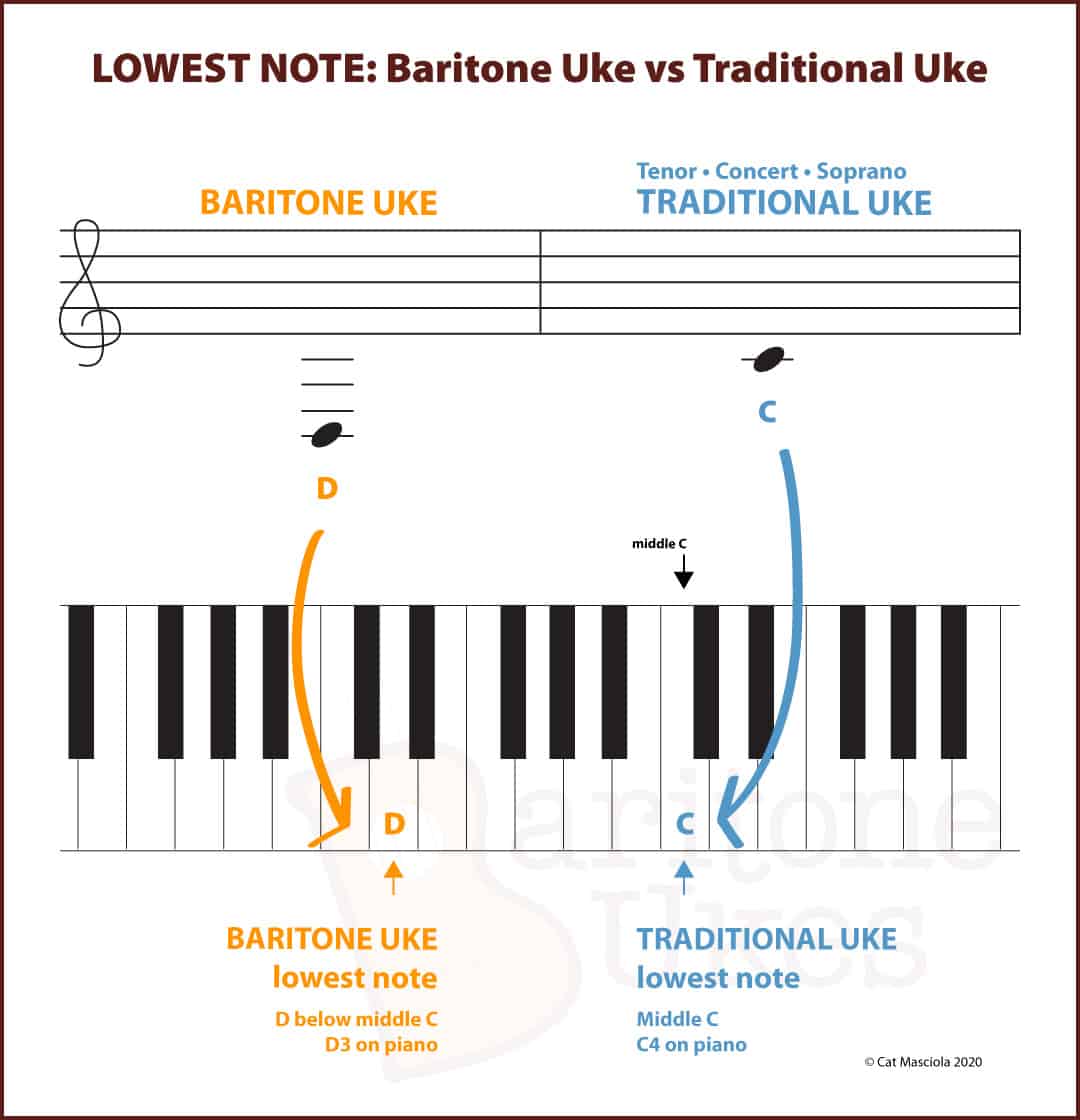
In fact, three of the four open strings on the bari uke are lower in pitch than the lowest-pitch string on the traditional uke. These rich resonant lower tones give you that guitar-like sound unique to baritone ukuleles. Bringing out the lower range is one the keys to choosing strings sets for the baritone uke. A good string set for baritone uke also needs to balance the low end with brightness and clarity in the higher notes, while maintaining equal volume across the strings.
Results of My Experiments
Each set of strings you try teaches you something. That’s why it’s so helpful to try your own experiments, and take notes. Don’t be afraid to change strings every three or four weeks if you want to. If you really don’t like a set, get rid of it. You don’t have to wear them out before you move on. Think of it as an educational expense, like lessons.
Make it a goal to try at least six different string sets in the coming year. Keep a notebook like this one:
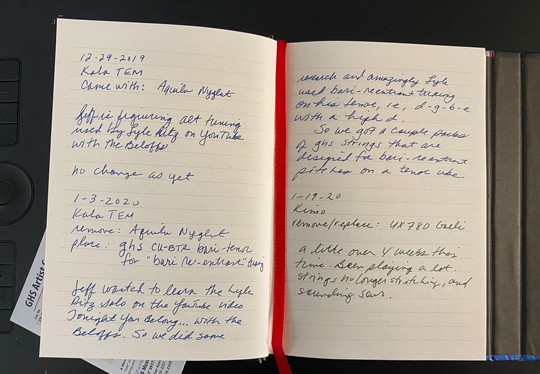

Results are updated, ongoing:
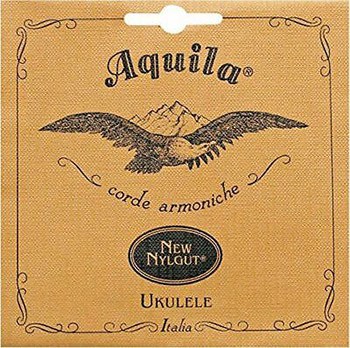
Aquila New Nylgut® 21U: I tried this pack on my Kimo bari. At about half the price of my favorite go-to set, the Galli UX780 above, the Aquila 21U set is a good value. They sound good and they feel good. The tension is nice and even across the strings. The sound is very similar to the Galli UX780 though to my ear UX780s are punchier and the 21Us have a little less volume and sustain, which you might prefer depending on your playing style. Nylgut® is a proprietary Aquila material which they describe as having a sonic profile almost identical to gut, with just 10% the humidity absorption of nylon. It is thicker than fluorocarbon. Italy. About US$6
Aquila apparently doesn’t publish string gauges.
E strings, white nylgut
B strings, white nylgut
G string, aluminum wound
D strings silvered plated copper wound

Dogal D119B: Two white wound and two clear. These appear to be exactly the same as the middle four strings of the flamenco set Galli GR105 above. Tried these on the Mike Pereira baritone, but the B string was too thick to fit through the pull-through bridge hole. I substituted with a B string from a Martin set I had on hand. The Dogal E string fits but is actually thicker than the Marin B string. Italy. About US$11.

Galli UX780: These are my go-to strings nowadays. I've used them on all three acoustic baritone ukes, the Lanikai, the Kimo, and the Mike Pereira. They have a very guitar-like sound with moderate, even tension. High strings and low strings are well balanced in tone and volume. Responsive without being too reactive for my skill level. Warm and mellow with punch. Made by Galli Strings, Napoli, Italy, a family company since 1890. About $12.
Some people don't like wound strings because they can squeak when you slide your fingers as you change chords. It's a sound you've heard thousands of times in recordings but it drives some people bats. Personally it doesn't bother me and I love the richer more resonate low tones you can get with wound low strings.
E String, clear fluorocarbon .022
B string, clear fluorocarbon .027
G string, silver plated wound .024
D string, silver plated wound .030
Update: As of this writing, I've tried the UX780 set nineteen times on three baritone ukes. They are hand down my favorite in the past three years.
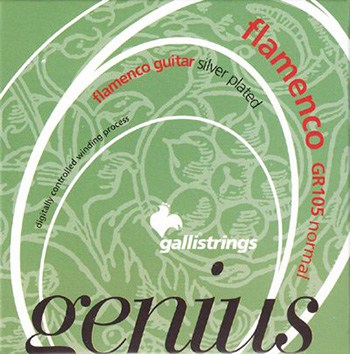
Galli Genius GR105 flamenco/classical guitar strings: I was curious about flamenco strings because I was learning a flamenco rumba strumming technique. (I’m crazy about flamenco! Check out this Marcelo Berestovoy lesson on YouTube.) I was curious about guitar strings too. I had read that the middle four strings from a guitar set could be used on a bari. I tried these on the custom Kimo. The E and B strings are crystal nylon and the G and D strings are coated silver plated on a multi-filament nylon core. Same concept as the rest of the Genius line but with the special gauges of the flamenco style.
The first thing I noticed was that the flamenco strings were very thick compared to what I was used to. It’s an interesting feel because your movements need to be more deliberate, yet loose and light. The tension felt about right. The sound is more muted and doesn’t ring out as much as others I’ve tried. These traits may be desirable for flamenco players because the style is fast, percussive, and energetic. To much ringing out may make it muddy, and light weight strings probably break too easily for this style. Galli Strings, Napoli, Italy. A family company since 1890. About US$12.
bari E String, guitar B string, crystal nylon .033 in.
bari B string, guitar G string, crystal nylon .042 in.
bari G string, guitar D string, silver plated on a multi-filament nylon .030 in.
bari D string, guitar A string, silver plated on a multi-filament nylon .035 in.
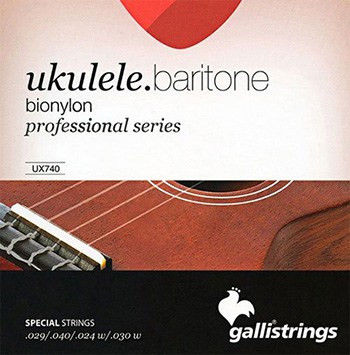
Galli Bionylon UX740: I tried these on the Kimo and the Lanikai. They sound great and feel comfortable. The D and G strings seem to be the same as the Galli UX780. At first I liked these even more than the Galli UX780. The two sets are very similar. But the sound of the UX780 set is just a little more to my liking. The 740s are stretchier. I’ll probably should try these again sometime. Galli Strings, Napoli, Italy. A family company since 1890. About $8.
E String, bionylon .029
B string, bionylon .040
G string, silver plated wound .024
D string, silver plated wound .030

GHS Set 100: Distinctive look with silver wound D and G strings and dark brown almost black nylon B and E strings. Tried them on the Kimo. I like the tension and the feel. Sweet and clear, articulate. Nice volume and sustain. Sound great. They are thicker gauge than my current favorite Galli UX870s. A bit more stiff. Maybe I should try these again sometime. GHS Strings, Battle Creek, Michigan (UPC 737681008475). About US$4.50.
E String, black nylon .028
B string, black nylon .036
G string, silver wound .027
D string, silver wound .034
Reader TJBRWN posted a video sound comparison on the BaritoneUkes subreddit comparing this set to the PhD set below. He’s playing his lovely Mele baritone ukulele. Thanks for sharing, TJBRWN!
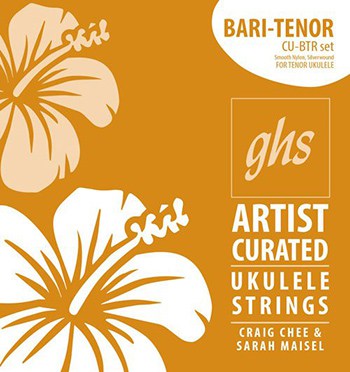
GHS CU-BTR: This is a special set designed for a tenor with bari re-entrant tuning, which means DGBE where the D is a high D. We use these on a Kala TEM tenor. My partner, Jeff, a pro pianist, is learning the Lyle Ritz solo on Tonight You Belong to Me, in which Lyle uses a bari re-entrant tuned tenor. (Here’s the Lyle Ritz video on YouTube, with Jim and Liz Beloff of Daily Ukulele fame, that inspired us to buy a tenor specially for baritone re-entrant tuning. Don’t miss the solo at 1:23). Jeff was so inspired by Lyle’s brilliant solo that he bought the Kala TEM tenor specifically for this tuning and to learn the piece the way Lyle does it. Lately he’s taken to playing Lyle’s uke solo on the piano. GHS Strings, Battle Creek, Michigan. (UPC: 737681446734). This set is artist curated with Craig Chee and Sarah Maisel. About US$5.
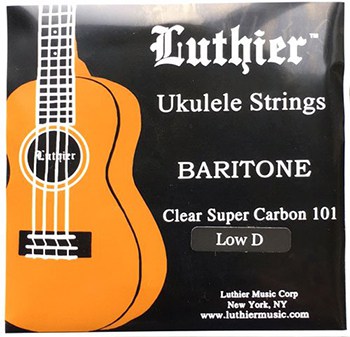
Luthier Clear Super Carbon 101, LU-Baritone-LD: I tried these on the Lanikai S-B spruce top mahogany baritone. The B and E strings are very similar to the Galli UX780 set above. The tension of the D and G string seem looser than the tension of the B and E strings. Not too stretchy. Sound is more mellow than bright. A good choice if you don’t like wound strings. Made from “clear hi-tech fluorocarbon, a Luthier exclusive.” Note: Luthier makes a matching high D set so this one would be a good one to try if you want to experiment with re-entrant tuning on your bari. Luthier Music, New York, NY (UPC 728816000242). About $US5.
E String, clear super carbon 0.64 mm
B string, clear super carbon 0.76 mm
G string, clear super carbon 0.86 mm
D string, clear super carbon 0.93 mm
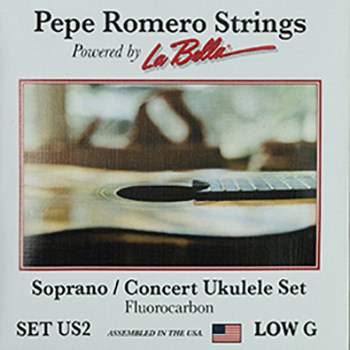
Pepe Romero US2 soprano/concert: The luthier who built my custom Kimo baritone chose these soprano/concert strings for this build because he prefers high tension. I gave them a try but found that the playing with higher tension requires more physicality in both the fretting hand and the strumming hand. Perhaps not for beginners? One of these days I’ll get around to trying the bari set. About $12.
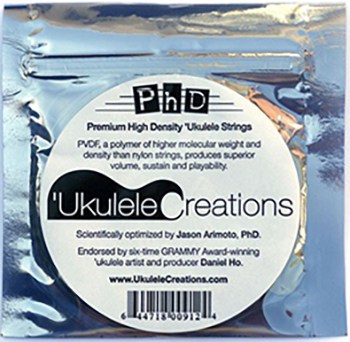
PhD Baritone LowD by Ukulele Creations: I tried these on the Kimo. More mellow than bright. Try these if you prefer unwound. Made from PVDF, a polymer of higher molecular weight and density than nylon strings, which, according to the manufacturer, produces superior volume, sustain and playability. Scientifically optimized by Jason Arimoto, PhD. Daniel Ho Creations, Los Angeles. They also offer a high D set and a low G set for baritone. About US$9.
Reader TJBRWN posted a video sound comparison on the BaritoneUkes subreddit comparing this set to the GHS Set 100 above. He’s playing his lovely Mele baritone ukulele. Thanks for sharing, TJBRWN!

Uke Logic Hard Tension fluorocarbon, unwound, H-BLD-C: Reader TJBRWN posted a video demo of these strings over on the the Baritone Ukes subreddit where players share tips and discuss questions. This set turned out to be his favorite among his experiments.
TJBRWN posted about his search for the perfect strings for his baritone uke. As an experienced player who’s tried a lot of string sets, he knew the sound and string tension he wanted, and he specifically was looking for unwound strings. He did some great research on calculating string tension for baritone ukulele and posted other sound comparisons too.
Uke Logic offers custom string sets so TJBRWN plans to swap out the D string for a slightly higher tension next time, which Uke Logic does at no extra charge.
E string, Orange .023
B string, Yellow .028
G string, Purple .036 (unwound)
D string, Black .042 (unwound)
Note: Because the super-carbon hard tension low D string is larger than most low D strings on the market (.042″), an adjustment to your nut slot may be needed for the string to seat properly.
TJBRWN added “After playing with this set for a while, I’ve decided that even with my desired tension, the volume, sustain, and resonance is noticeably less than with my original wound strings. If you’re only playing acoustically (and not playing long sessions enough for the metal to completely shred your fingertips), I will concede that wound strings will likely sound better. However, it works well for my particular case because I use a misi pickup and some pedals to boost the signal and record.”
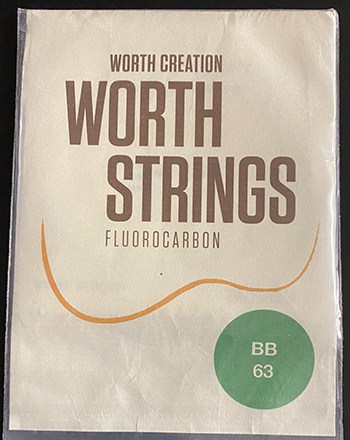
Worth Brown BB: I tried these on the Lanikai S-B. These were very flexible, responsive, and stretchy. They are much thinner than the white nylon that comes with most ukes these days. The sound is more bright than mellow. I tried them as a beginner when my hands weren’t very coordinated yet and my movements were more exaggerated than necessary. I didn’t have that much dexterity yet. I felt like these strings would be better for a more experienced player because they were so responsive. By the way, the brown color looks absolutely great with just about any wood, so if you’re into aesthetics, you’ll like these. The pack includes double-length strings. You cut them in half, getting two sets per pack, which is why they cost around double of other brands. Japan (UPC 4560481151173). About US$15, double length, cut in half for two sets.
E String, brown fluorocarbon .0244 in.
B string, brown fluorocarbon .0291 in.
G string, brown fluorocarbon .0319 in.
D string, brown fluorocarbon .0358 in.
Update: I tried these strings about 2.5 years later and found that I liked them much more once I had more dexterity in my fingers. I prefer to use them on my tenor (a Kala cedar top ziricote) because for the baritones I prefer the wound D and G strings. This set is for players who like softer tension.
Conduct your own experiments
- play at least 5 minutes every day
- change strings at least 6 times in the next year
- try different strings each time
- take notes
- when you take the strings off, compare the old to the new – what do you notice?
If you’d like to participate in this ongoing string experiment for baritone ukulele, post in the comments below and let us know which strings you tried, which instrument you tried them on, and tell us the results. If you didn’t like them, tell us what type of player, situation, or instrument might be a better match for the set. If you did like them, tell us how they suit you and why.
Here are some criteria you can use to evaluate the sets you try:
- flexibility and responsiveness
- durability – do they break easily?
- tension – do they feel loose, tight, or in between?
- appearance – how do they look?
- wound or unwound low strings – which do you prefer
- price/value
- sound – clear, bright, warm, resonant, muted, etc
- sustain – do they ring out more or less than you prefer?
- volume and projection
- feel – thick, thin, slippery, rough, etc
- evenness of characteristics across all four strings
- availability – where can you get them?
- stretchiness – how long does it take for them to settle?
Just Play
String players have a river of strings ebbing and flowing throughout their lives, so don’t obsess about string choice too much. Grab different sets and just play! You’ll soon discover the sound and feel that you like best.



Thanks for sharing your results! I too keep a journal of my string changes and reactions to them. I haven’t tried Galli’s you recommend. I have an old Harmony bari that is a good friend and will try them on it as the opportunity arises.
Thanks! Let me know how like them 🙂
John S. says: The Gallis are unique: no thump to the wound strings and excellent tonal balance with the trebles. They also capo well!